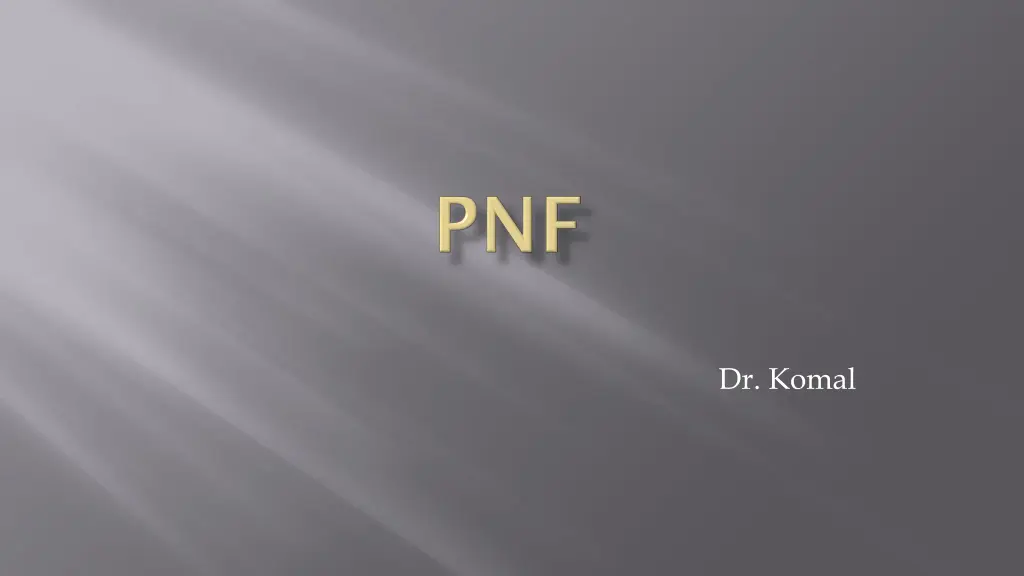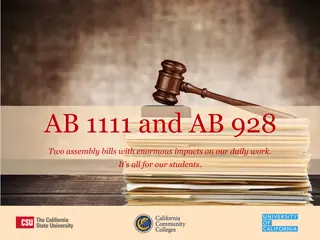
Understanding Proprioceptive Neuromuscular Facilitation (PNF) Techniques
Explore the history, definition, and principles of Proprioceptive Neuromuscular Facilitation (PNF) techniques, a specialized form of exercise used in sports rehabilitation. Learn about the benefits of PNF for functional improvement in motor output and its role in facilitating muscle groups through graded resistance and facilitatory procedures.
Download Presentation

Please find below an Image/Link to download the presentation.
The content on the website is provided AS IS for your information and personal use only. It may not be sold, licensed, or shared on other websites without obtaining consent from the author. If you encounter any issues during the download, it is possible that the publisher has removed the file from their server.
You are allowed to download the files provided on this website for personal or commercial use, subject to the condition that they are used lawfully. All files are the property of their respective owners.
The content on the website is provided AS IS for your information and personal use only. It may not be sold, licensed, or shared on other websites without obtaining consent from the author.
E N D
Presentation Transcript
DEFINITION Proprioceptive: having to do with any of the sensory receptors that give information concerning movement and position of the body Neuromuscular: involving the nerves and muscles Facilitation: making easier
Proprioceptive neuromuscular facilitation is exercise based on the principles of functional human anatomy and neurophysiology. It uses Proprioceptive Cutaneous Auditory input To produce functional improvement in motor output and can be a vital element in the rehabilitation process of sports related injuries
A PNF technique is a sequenced method of facilitation, which aims at an improvement of body functions or activities within the context of a treatment goal. The goal of the PNF techniques is to promote functional movement through facilitation, inhibition, strengthening, and relaxation of muscle groups. The techniques use concentric, eccentric, and static muscle contractions. These muscle contractions with properly graded resistance and suitable facilitatory procedures are combined and adjusted to fit the needs of each patient
History of PNF : Mid -1940 s : Neurophysiologist Dr. Herman Kabat developed PNF to rehabilitate the muscle of polio patients 1950 s : Techniques were further developed with Maggie Knott and Dr. Dorothy Voss Mid 1950 s : PNF work published in scientific journals 1960 s : Taught in universities 1970 s : Used by athletes
PNF- is rehabilitation technique- proprioceptive system- facilitates NM system- desired momt. If we activate afferent system you will get efferent system activated. 3 core principles: Integrated approach(body as a whole) Positive approach-physical & mental(what pt can do) Achieve high level of function
Plasticity: Refers to brains ability to recognize neural pathways throughout the lifespan as a result of experience. The brain ability to change with learning. There is a change in the structure of the neurons , notably the synapses & increase in the number of synapses. All other systems have the ability to develop plasticity( MSK & CV)
Indications of PNF: Muscular weakness Jt stiffness Fatigue Pain Relaxation Initiation difficulty coordination
Increase strength, flexibility, coordination & functional mobility. Facilitate the pt in achieving a movt or posture Stretches as well as diagonals & rational ex patterns are used to improve ADL s functional mobility & athletic performance.
All human beings have potentials that are not fully developed. Motor development takes place in cerviocaudal sequence or proximodistal direction. Early motor behavior is dominated by reflex activity whereas mature motor behavior is supported or reinforced by postural reflex. The growth of motor behavior has cyclic trends as evidenced by shifts between flexor and extensor dominance. The goal directed activity is made up of reversing movements. Normal movement and posture are dependent upon synergism and a balanced interaction of antagonist. Developing motor behavior is expressed in an orderly sequence of total patterns of movements and posture. Normal development has an orderly sequence but lacks a step by step quality and generally shows overlap. Improvement in motor ability depends upon motor learning. Frequency of stimulation and repetitive activity are used to promote and retain motor learning as well as for the development of strength and endurance.
1. After discharge:- stimulus-response(effect), stimulus stops- response still present for sometime- after discharge. If intensity or duration(stimulus) is increased - after discharge is increased. Ex- the feeling of increased power for sometime after exersing in a gym. 2. Temporal summation:- (time addition)- when there is a single wk stimuli, unable to produce response. If we keep on giving no of wk stimuli but in certain period of time, then they add up to produce a response. Occurs by adding up of high Fq stimulation by one presynaptic neuron produces the response in postsynapyic neuron
3. Spatial summation:- when wk stimuli are applied simultaneously over different parts of the body, then they can also add up to produce a response. Occurs by adding up of multiple stimuli from different neurons. i.e from different pre synaptic neurons when they are stimulated by stimulus they can combine to reach a threshold in order to stimulate the post synaptic neuron.
4. Irradiation:- refers to the overflow of energy. This occurs from stronger muscle groups to the wk ms groups. Occurs when there is increase in the strength of the stimulus or no of stimulus. This helps the therapist to exercise the wk ms by utilizing the stronger synergistic ms.
5. Successive induction:- successive (in turn/turn by turn). Induction(stimulus/excitation). When the agonist have contracted maximally it is the time now for antagonist to get stimulated.
6. Reciprocal inhibition:- excitation or contraction of particular muscle is simultaneously accompanied by inhibition of its antagonist.
Manual contacts Traction & Approximation Stretch Maximal Resistance Irradiation & reinforcement Verbal (commands) Vision Timing & Timing for emphasis Body position and mechanics Patterns
Provide basic tools for therapist to develop efficient motor control. Improve mobility Improving stability Reducing fatigue Improving co-ordination Improving strength
The therapists grip stimulates the patientsskin receptors and otherpressurereceptors. Thetherapist shand should beplaced toapplythe pressure oppositethedirectionof motion. Tostimulateproprioceptors in muscles, tendonsand joints. Maybeused withorwithoutresistance.
Traction iselongationof trunkoranextremity. Itisused tofacilitatemotion/ increase jtROM and aid inelongationof musclewhenusing stretchreflex. And for pain relief. Approximation is the compression of the trunk or extremity. It promotesstabilization, facilitatesweight bearingand facilitates uprightreactions. Both increase propioceptive input
Stretch stimulus: Occurswhenthemuscleis elongated. Itfacilitates musclecontraction. Can be given to individual ms or to whole synergistic muscle. Given to whole synergistic ms will increase ms activity. Precaution:- use of stretch reflex is not advisable during the earlystageof soft tissuehealing afterinjuryorsurgery.
Timing is a sequencing of motions. Normal timing provides continuous coordinated motion until the task is accomplished. Timing for emphasis involves changing the normal sequencing of motions to emphasize a particular muscle or desired activity.
The amount of resistance provided during an activity must be appropriate for the patients condition and the goal of the activity. 1. Facilitates muscle contraction. 2. Increases motor control and learning. 3. Increases strength. improve motion awareness. Resistance should not be too less or too much. Breath should not be held by patient or therapist.
Overflow of a response when resistance is applied properly it can result in irradiation & reinforcement. Reinforcement means strengthen further.
The therapists body should be in line with desired motion or force. The resistance comes from the therapist s body, while the hands and arms stay comparatively relaxed. By using body weight, the therapist can give prolonged resistance without fatigue.
The verbal command tells the patient what to do and when to do it. The command is divided into three parts . a. Preparation b. Action c. Correction Louder commands- for ms contractions Soft tone- ms relaxation/pain.
Thefeedback fromthevisual sensorysystemcan promotea more powerfulcontraction. Ithelpsthepatienttocorrectpositionand motion. Itprovidesanotheravenueof communicationand helpstoensure co-operative interaction.
Patterns The patterns of movement associated with PNF are composed of multijoint, multiplanar, diagonal and rotational movements of extremities, trunk and neck. There are two pairs of diagonal patterns for upper and lower extremities. 1. Diagonal 1 2. Diagonal 2 Each of these pattern patterns can be performed in either flexion or extension.
D1 flexion D1extension D2 flexion D2extension of theupperand lowerextremities
D1 flexion:- flexion, adduction,external rotation D1extension:- extension,abduction, internal rotation D2 flexion:- flexion, abduction,external rotation D2extension:- extension,adduction, internalrotation
D1 flexion:- flexionorextension D1extension:- flexionorextension D2 flexion:- flexionorextension D2extension:- flexionorextension
D1 flexion:- Supination D1extension:- Pronation D2 flexion:- Supination D2extension:- Pronation
D1 flexion:- flexion, radial deviation D1extension:- extension, ulnardeviation D2 flexion:- extension,radial deviation D2extension:- flexion, ulnardeviation
D1 flexion:- flexion,adduction D1extension:- extension,abduction D2 flexion:- extension,abduction D2extension:- flexion,adduction
Lower Extremity Component Motions Hip: D1 flexion:- flexion, adduction,external rotation D1extension:- extension,abduction, internal rotation D2 flexion:- flexion, abduction, internal rotation D2extension:- extension,adduction,external rotation
Knee D1 flexion:- flexionorextension D1extension:- flexionorextension D2 flexion:- flexionorextension D2extension:- flexionorextension
Ankle D1 flexion:- dorsiflexion, inversion D1extension:- plantarflexion, eversion D2 flexion:- extension,eversion D2extension:- plantarflexion, inversion
Toes D1 flexion:- extension D1extension:- flexion D2 flexion:- extension D2extension:- flexion
Rhythmic Initiation Rhythmic motion of the limb or body through the desired range, starting with passive motion and progressing to active resisted movement. Goals:- Improve coordination and sense of motion. 1. Teach the motion 2. Help the patient to relax 3. Normalize the rate of motion, either increasing or decreasing it 4.
Indications:- Difficulties in initiating motion 1. Movement too slow or too fast 2. Uncoordinated or dysrhythmic motion, i.e.,ataxia and rigidity 3. Regulate or normalize muscle tone 4.






















